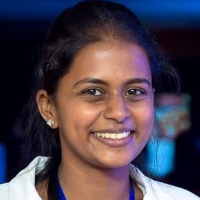International Journal of Information Technology and Computer Science (IJITCS)
IJITCS Vol. 10, No. 2, 8 Feb. 2018
Cover page and Table of Contents: PDF (size: 451KB)
An ICT Based Solution for Virtual Garment Fitting for Online Market Place
Full Text (PDF, 451KB), PP.60-72
Views: 0 Downloads: 0
Author(s)
Index Terms
Anthropometry, virtual garment fitting, avatar generation, generic body model, ease allowance
Abstract
In this paper, we describe various technologies that are being used in virtual garment fitting and simulation. There, we have focused on the usage of anthropometry in the clothing industry and avatar generation of virtual garment fitting. Most commonly used technologies for avatar generation in virtual environment have been discussed in this paper such as generic body model method and laser scanning technologies. Moreover, this paper includes the usage of real-time tracking technologies used in virtual garment fitting like markers and depth cameras. Apart from these, virtual clothing methods such as geometrical, physical and hybrid-based models were also discussed in this paper. As ease allowance has a major impact on virtual cloth fitting, it is also considered in this paper relating to similar research studies. As the final stage, our proposed design has been explained including the steps of the experiment that has been conducted to generate a two-dimensional model of the garment item. Within this paper, all the above-mentioned areas were described thoroughly while stating the existing gap of the virtual garment fitting in online marketplaces and our proposed solution to bridge that gap.
Cite This Paper
Hashini Gunatilake, Dulaji Hidellaarachchi, Sandra Perera, Damitha Sandaruwan, Maheshya Weerasinghe, "An ICT Based Solution for Virtual Garment Fitting for Online Market Place", International Journal of Information Technology and Computer Science(IJITCS), Vol.10, No.2, pp.60-72, 2018. DOI:10.5815/ijitcs.2018.02.06
Reference
[1]D. Kim and K. LaBat, "Consumer experience in using 3D virtual garment simulation technology", Journal of the Textile Institute, vol. 104, no. 8, pp. 819-829, 2013.
[2]S. Pheasant and C. Haslegrave, Bodyspace: Anthropometry, Ergonomics and the Design of Work, 3rd ed. Boca Raton, FL.: Taylor & Francis, 2006.
[3]N. Schofield and K. LaBat, "Exploring the Relationships of Grading, Sizing, and Anthropometric Data", Clothing and Textiles Research Journal, vol. 23, no. 1, pp. 13-27, 2005.
[4]H. Huang, P. Mok, Y. Kwok and J. Au, "Block pattern generation: From parameterizing human bodies to fit feature-aligned and flattenable 3D garments", Computers in Industry, vol. 63, no. 7, pp. 680-691, 2012.
[5]Y. Chen, X. Zeng, M. Happiette, P. Bruniaux, R. Ng and W. Yu, "A new method of ease allowance generation for personalization of garment design", International Journal of Clothing Science and Technology, vol. 20, no. 3, pp. 161-173, 2008.
[6]Cordier, Frédéric et al. "Virtual-Try-On On The Web". VRIC, Virtual Reality International Conference Laval Virtual 2001. Web. 4 May 2017.
[7]D. Protopsaltou, C. Luible, M. Arevalo and N. Magnenat-Thalmann, "A body and Garment Creation Method for an Internet Based Virtual Fitting Room.", Advances in Modelling, Animation and Rendering, pp. 105-122, 2002.
[8]A. Divivier, Dr. R. Trieb, A. Ebert and H. Hagen, "Virtual Try-On Topics in Realistic, Individualized Dressing in Virtual Reality", Web 4 May 2017.
[9]S. Hauswiesner, M. Straka and G. Reitmayr, "Free viewpoint virtual try-on with commodity depth cameras", Proceedings of the 10th International Conference on Virtual Reality Continuum and Its Applications in Industry - VRCAI '11, 2011.
[10]"OpenNI | http://myrobotlab.org", Myrobotlab.org, 2012. [Online]. Available: http://myrobotlab.org/service/openni. [Accessed: 05- May- 2017].
[11]K. Kortbek, K. Grønbæk and H. Hedegaard, "ARDressCode: Augmented Dressing Room with Tag-based Motion Tracking and Real-Time Clothes Simulation", in Central European Multimedia and Virtual Reality Conference, 2005.
[12]"Follow-the-Trial-Fitter: Real-time dressing without undressing", in Third International Conference on Digital Information Management, London, UK, 2008.
[13]M. Sekine, K. Sugita, F. Perbet, B. Stenger and M. Nishiyama, "Virtual Fitting by Single-shot Body Shape Estimation", in 5th International Conference on 3D Body Scanning Technologies, Lugano, Switzerland, 2014.
[14]F. Cordier, Hyewon Seo and N. Magnenat-Thalmann, "Made-to-measure technologies for an online clothing store", IEEE Computer Graphics and Applications, vol. 23, no. 1, pp. 38-48, 2003.
[15]P. Volino and N. Magnenat-Thalmann, Virtual Clothing, 1st ed. Springer-Verlag GmbH: Springer-Verlag, 2000.
[16]J. Weil, "The synthesis of cloth objects", ACM SIGGRAPH Computer Graphics, vol. 20, no. 4, pp. 49-54, 1986.
[17]Y. Agui and M. Nakajima, "An expression method of cylindrical cloth objects-an expression of folds of a sleeve using computer graphics", 1990.
[18]B. Hinds and J. McCartney, "Interactive garment design", The Visual Computer, vol. 6, no. 2, pp. 53-61, 1990.
[19]B. Hinds, J. McCartney and G. Woods, "Pattern development for 3D surfaces", Computer-Aided Design, vol. 23, no. 8, pp. 583-592, 1991.
[20]C. Calladine, Gaussian curvature and shell structures, The Mathematics of Surfaces, 1st ed. Oxford, England: Clarendon Press, 1986, pp. 179-196.
[21]J. Miller, D. Breen, W. Lorensen, R. O'Bara and M. Wozny, "Geometrically deformed models", ACM SIGGRAPH Computer Graphics, vol. 25, no. 4, pp. 217-226, 1991.
[22]T. Stumpp, J. Spillmann, M. Becker and M. Teschner, "A Geometric Deformation Model for Stable Cloth Simulation", in Workshop on Virtual Reality Interaction and Physical Simulation, 2008.
[23]P. Decaudin, D. Julius, J. Wither, L. Boissieux, A. Sheffer and M. Cani, "Virtual Garments: A Fully Geometric Approach for Clothing Design", Computer Graphics Forum, vol. 25, no. 3, pp. 625-634, 2006.
[24]C. Wang, Y. Wang and M. Yuen, "Feature based 3D garment design through 2D sketches", Computer-Aided Design, vol. 35, no. 7, pp. 659-672, 2003.
[25]T. Igarashi and J. Hughes, "Clothing Manipulation", in 15th Annual ACM Symposium on User Interface Software and Technology, UIST ’02, ACM, 2002, pp. 91–100.
[26]J. Wang, G. Lu, W. Li, L. Chen and Y. Sakaguti, "Interactive 3D garment design with constrained contour curves and style curves", Computer-Aided Design, vol. 41, no. 9, pp. 614-625, 2009.
[27]Y. Meng, C. Wang and X. Jin, "Flexible shape control for automatic resizing of apparel products", Computer-Aided Design, vol. 44, no. 1, pp. 68-76, 2012.
[28]R. Brouet, A. Sheffer, L. Boissieux and M. Cani, "Design preserving garment transfer", ACM Transactions on Graphics, vol. 31, no. 4, pp. 1-11, 2012.
[29]E. Turquin, J. Wither, L. Boissieux, M. Cani and J. Hughes, "A Sketch-Based Interface for Clothing Virtual Characters", IEEE Computer Graphics and Applications, vol. 27, no. 1, pp. 72-81, 2007.
[30]N. Umetani, D. Kaufman, T. Igarashi and E. Grinspun, "Sensitive couture for interactive garment modeling and editing", ACM Transactions on Graphics, vol. 30, no. 4, p. 1, 2011.
[31]D. Terzopoulos, J. Platt, A. Barr and K. Fleischer, "Elastically deformable models", ACM SIGGRAPH Computer Graphics, vol. 21, no. 4, pp. 205-214, 1987.
[32]P. Volino and N. Magnenat-Thalmann, "Accurate Garment Prototyping and Simulation", Computer-Aided Design and Applications, vol. 2, no. 5, pp. 645-654, 2005.
[33]S. Kawabata, M. Niwa and Y. Yamashita, "A guideline for manufacturing “ideal fabrics”", International Journal of Clothing Science and Technology, vol. 11, no. 23, pp. 134-144, 1999.
[34]A. De Boos, D. Tester and A. De Boos, SiroFast, Fabric Assurance by Simple Testing, 1st ed. Geelong: CSIRO Division of Wool Technology, 1997.
[35]P. Volino, N. Magnenat-Thalmann and F. Faure, "A simple approach to nonlinear tensile stiffness for accurate cloth simulation", ACM Transactions on Graphics, vol. 28, no. 4, pp. 1-16, 2009.
[36]M. Chen and K. Tang, "A fully geometric approach for developable cloth deformation simulation", The Visual Computer, vol. 26, no. 6-8, pp. 853-863, 2010.
[37]I. Rudomin, "Simulating cloth using a mixed geometric-physical method", Ph.D, Philadelphia University,USA, 1990.
[38]T. Kunii and H. Gotoda, "Singularity theoretical modeling and animation of garment wrinkle formation processes", The Visual Computer, vol. 6, no. 6, pp. 326-336, 1990.
[39]N. Tsopelas, "Animating the Crumpling Behavior of Garments", in 2nd Eurographics Workshop on Animation and Simulation, 1991, pp. 11-24.
[40]S. Hadap, E. Bangerter, P. Volino and N. Magnenat-Thalmann, "Animating wrinkles on clothes", in conference on Visualization ’99: celebrating ten years, VIS ’99, 1999, pp. 175–182.
[41]L. D. Cutler, R. Gershbein, X. Wang, C. Curtis, E. Maigret, L. Prasso and P. Farson, "An art-directed wrinkle system for CG character clothing", in 2005 ACM SIGGRAPH/Eurographics symposium on Computer animation, SCA ’05, 2005, pp. 117–125.
[42]T. Popa, Q. Zhou, D. Bradley, V. Kraevoy, H. Fu, A. Sheffer and W. Heidrich, "Wrinkling Captured Garments Using Space-Time Data-Driven Deformation", Computer Graphics Forum, vol. 28, no. 2, pp. 427-435, 2009.
[43]W. Feng, Y. Yu and B. Kim, "A deformation transformer for real-time cloth animation", ACM Transactions on Graphics, vol. 29, no. 4, p. 1, 2010.
[44]J. Rasband and E. Liechty, Fabulous fit, 2nd ed. New York City, NY: Fairchild Publications, 2006.
[45]S. Gill, "Improving garment fit and function through ease quantification", Journal of Fashion Marketing and Management: An International Journal, vol. 15, no. 2, pp. 228-241, 2011.
[46]J. Xu, W. Zhang and P. Xiao, "A study on impact factors of the distance eases between body and garment", in 9th International Conference on Computer-Aided Industrial Design and Conceptual Design, Kunming, China, 2008, pp. 201-205.
[47]A. Lage and K. Ancutiene, "Virtual try-on technologies in the clothing industry. Part 1: investigation of distance ease between body and garment", The Journal of The Textile Institute, pp. 1-7, 2017.
[48]S. Thomassey and P. Bruniaux, "A template of ease allowance for garments based on a 3D reverse methodology", International Journal of Industrial Ergonomics, vol. 43, no. 5, pp. 406-416, 2013.
[49]Z. Wang, E. Newton, R. Ng and W. Zhang, "Ease distribution in relation to the X-line style jacket. Part 1: Development of a mathematical model", Journal of the Textile Institute, vol. 97, no. 3, pp. 247-256, 2006.
[50]W. Aldrich, Metric pattern cutting for menswear. Oxford: BSP Professional Books, 1990.




